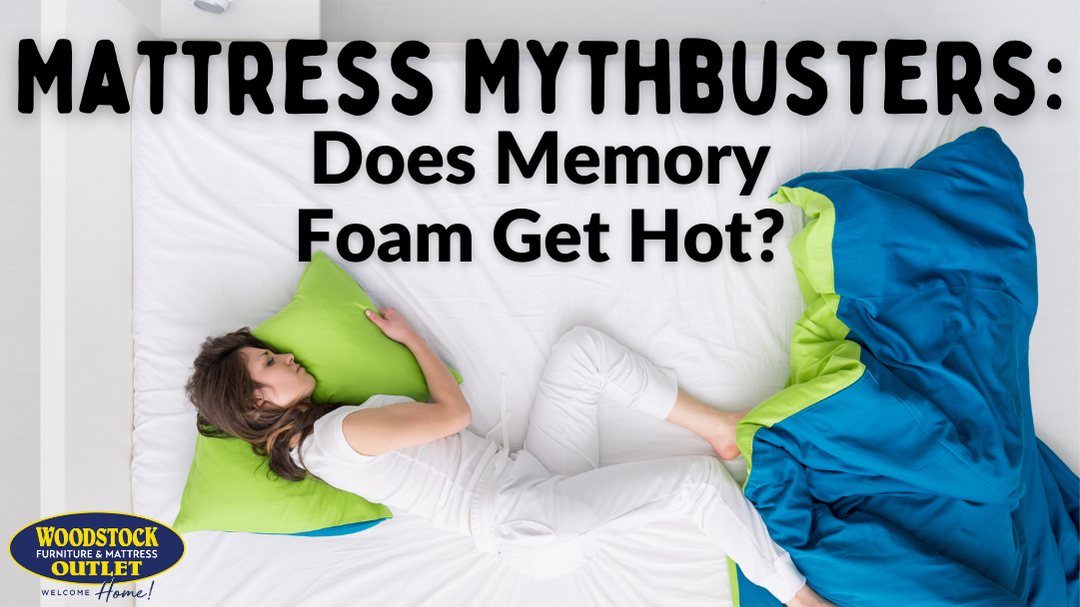“No, no, I don’t want one of those. I’m a hot sleeper and I’ve heard those mattresses get way too hot.” Like it or not, we hear this quote from mattress shoppers on a daily basis. Usually this objection is directed towards memory foam, gel memory foam, or even Tempur-Pedic mattresses. Sometimes we even encounter shoppers reluctant to try hybrid mattresses due to the foam involved in their construction. But is it true? Does memory foam get hot?
As a mattress retailer with over three decades experience, we’ve been helping our customers sleep better for a long time. We also carry a variety of brands and mattress types, from traditional innerspring mattresses, to gel memory foam, to hybrids and other alternatives from mattress industry innovators like Tempur-Pedic and Purple. However, because we carry memory foam mattresses along with a bunch of other alternative options, we feel we’re well-equipped to address the age-old memory foam heating question.
Nobody wants to sweat throughout the night, and we don’t want that for our customers either. That’s why we’re committed to educating sleepers and directing them to the mattresses that best fit them — whether they be memory foam, innerspring, hybrid or otherwise!
So, are memory foam mattresses hot? Are the concerns about memory foam, hot sleepers, and overheating valid? Or are they completely overblown? Keep scrolling to find out!
Fact or Fiction: Are Memory Foam Mattresses Hot?

Yes, memory foams are incredibly dense and they retain massive amounts of heat. Fact. That concludes today’s discussion on memory foam. Thanks for coming!
Okay, just kidding. It’s not that simple. That may have been the truth once-upon-a-time. However, there have been lots of advancements in both memory foam and mattress manufacturing since viscoelastic foams first gained popularity as a mattress construction material in the 90s and early 2000s.
It’s true that early memory foam mattresses had a real problem trapping heat and storing it up against the sleeper. As you’ve likely heard, memory foam has a tendency to absorb body heat due to its extremely dense nature. Well, it turns out that although the average sleeper has a body temperature of 98.6 degrees, they don’t want to sleep in a bed that feels like it’s 98.6 degrees!
Despite the incredible breakthroughs memory foam offered sleepers in the areas of pressure relief and contouring, hot sleepers were forced to compromise between these wonderful benefits and frequent night sweats. Something had to change. And it did — eventually.
The Cooling Story: 4 Ways Mattress Manufacturers Combat Heat Retention in Memory Foam
While it’s true that memory foam and other viscoelastic foams retain heat in their natural state, mattress manufacturers have been mitigating this risk over the last 10 to 15 years. In fact, almost every foam mattress made today has some sort of cooling story. This is true from the most affordable Sierra Sleep memory foam mattresses to the most expensive Tempur-Pedic mattresses on the market.
There are 4 different ways that mattress makers design modern foam and hybrid mattresses in order to address the memory foam heating problem. Manufacturers may use the individual solutions below (or any combination of them) to cool a naturally hot memory foam mattress.
#1) Moisture-Wicking & Heat-Wicking Mattress Covers
At bare minimum, almost every mattress brand making memory foam, gel memory foam or hybrid mattresses today includes a moisture-wicking or heat-wicking mattress cover. Most often these covers are made from fabrics like Tencel, modal or bamboo viscose.

A more advanced evolution of this can be seen with models like the Nectar Premier Copper mattress. Since copper is one of nature’s best thermal conductors, the mattress cover’s copper-infused threads easily transport excess heat away from the sleeper.
While each of these fabric blends have their own characteristics, they all have properties that help move moisture and/or heat away from the sleeper to keep them cool and dry. This helps combat that clammy, stuffy, overheated feeling consumers have complained about in the past.
#2) Vents & Air Channels
Another solution to heat build-up in memory foam mattresses is to find a way to increase airflow through the mattress to keep sleepers cool. Most often, this is done using vents, ventilation holes, or other air channels. This cooling method is commonly used in foam pillows and mattress toppers as well.
In fact, this is the single largest reason shoppers shouldn’t have heat concerns about hybrid mattresses, despite their use of various memory foams in their construction. This is because the spring coils used in innerspring and hybrid mattresses naturally act as channels through which air can move. Some hybrid mattresses from Sealy and Stearns & Foster, even have specially ventilated edge coils or external vents.
#3) Gel Infusion (Gel Memory Foam)
This is a big one. Have you heard the words “gel memory foam” since embarking on your mattress buying journey? If so, you’ve already encountered possibly the biggest way many mattress makers have addressed the concerns about memory foam mattresses getting hot. In fact, a decent percentage of memory foam mattresses and accessories on the market these days are now made of gel memory foams.

But what is gel memory foam, and how is it different from regular memory foam? Gel-infused memory foams offer the same contouring and pressure relief as regular memory foams. However, the key difference is the presence of cooling gels that are either layered on top of the memory foam, or blended into the memory foam itself. Most often, countless, tiny gel beads are mixed into the foam as it is being made and end up suspended within the foam itself.
The purpose of this gel infusion is to break up the dense, heat-absorbing surface of the memory foam. While the exact composition of the gels vary depending on the manufacturer, these gels are made of temperature-neutral materials designed to prevent excess heat absorption.
#4) Phase Change Materials (PCMs)
That leads us to the final, and literally coolest way of mitigating heat build-up in memory foam — phase change material. Phase change materials really are the cutting edge of temperature regulating technology.
So, what are phase change materials and how do they work? Phase change materials (or PCMs for short) are designed to adapt to the sleeper’s body temperature, and regulate it. That’s because PCMs store heat when needed and release heat when needed to restore the desired temperature.
The “phase change”, in phase change materials, refers to the ability of matter to change states. For instance, the way that water molecules change from solid ice to a liquid water at 32°F, and from a liquid to water vapor at 212°F. These are phase changes. What you need to understand is that energy is transferred whenever these states change, like steam off a boiling pot of water.
So, why does this matter? As the name indicates, phase change materials within a mattress begin as one state and transform to another. In the case of mattresses, these PCMs usually go from a solid to a gel. Most often, these materials are a thin layer within the mattress that slowly absorbs the heat as it “liquifies” from a solid to a gel, pulling heat away from the sleeper and cooling the mattress in the process.
The awesome part is that it also works in reverse. As PCM eventually cools, it also solidifies, and releases just enough of the stored heat to maintain the perfect temperature balance. Instead of a mattress that is constantly too hot or too cold, PCM constantly balances the mattress to the just-right temperature. Goldilocks will never have to try another bed ever again.
However, just remember that not all phase change materials are created equal. PCMs can also be used to make mattresses where the temperature equilibrium is engineered to be a little lower. For instance, in Tempur-Pedic’s incredible PRObreeze and LUXEbreeze mattresses, PCMs are a huge part of how they were able to design mattresses to maintain a constant temperature feeling between 5 degrees and 10 degrees cooler than standard TEMPUR-Adapt foam.
So, Does Memory Foam Really Get Hot?
The whole truth is, yes. And no. On their own, memory foams and viscoelastic foams of all types can trap body heat and be a problem for hot sleepers. But these days, almost every mattress manufacturer has taken steps to mitigate this. While this mattress myth isn’t necessarily “busted”, it’s certainly a bigger concern in the minds of consumers than it should be.
But do these new and improved memory foam and gel memory foam mattresses still sleep hotter than hybrid and innerspring mattress alternatives? Sometimes they do. But that really depends on the mattress in question and how much cooling or temperature regulating technology is built into it. An entry-level memory foam mattress will still likely sleep warmer than most hybrids and innerspring mattresses. By contrast, a top-of-the-line cooling TEMPUR material mattress like Tempur-Pedic’s LUXEbreeze may just be the coolest sleeping mattress on the planet.
Just remember, not all foams are created equal and some will sleep cooler than others. Although heat build-up is no reason to shy away from foam mattresses as a whole, particularly hot sleepers should consider foam mattresses with at least a couple of the cooling features above.
Do you live in the metro Atlanta area or elsewhere in North Georgia? You should come try out a number of these different foam mattresses for yourself. And if you decide an innerspring or a hybrid mattress is better for you, we’ve got loads of them too! Come see us today at our furniture and mattress stores in Acworth, Dallas/Hiram and Rome, and our mattress-only showrooms in Canton, Kennesaw and Douglasville.







